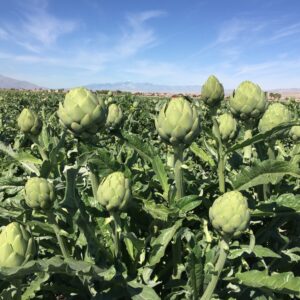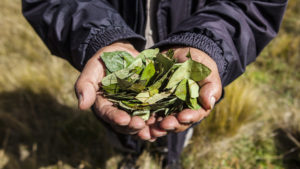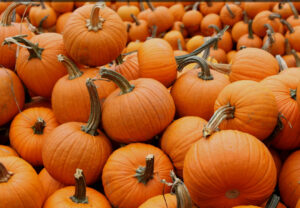Artichokes: The Prize Under the Thistles
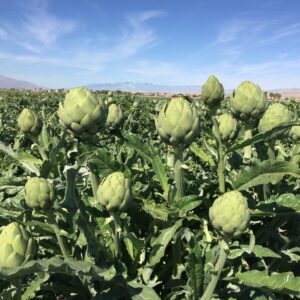
*TODAY’S LESSON: The Wonderful World of Artichokes**
Artichokes are one of the most forbidding looking of the vegetable family with thistle thorns protecting its sweet inner heart. The flavor is naturally rich and sweet with carbohydrate fiber that are great for you. Today we will strip away the stickers and release the artichoke’s inner heart.
**WHAT EXACTLY IS AN ARTICHOKE?**
The artichoke is a giant thistle of the daisy family. The edible flower would bloom deep purple if allowed to mature.
**WHERE DO THEY COME FROM:**
Artichokes are believed to have originated in the Mediterranean region, particularly around the area of present-day Southern Europe and North Africa. They have been cultivated for thousands of years and were prized by ancient civilizations such as the Greeks and Romans for their culinary and medicinal properties. Artichokes were later introduced to other parts of Europe and the Americas through trade and exploration.
Artichokes are primarily grown in California, particularly along the central coast region, which has a Mediterranean-like climate that is ideal for artichoke cultivation. Some of the key artichoke-growing areas in California include Castroville, Salinas Valley, and the Monterey area. Additionally, artichokes are also grown in smaller quantities in states like Arizona and Washington.
Artichokes thrive in the hot days and cool, foggy nights of the Central coast and are at their peak from the end of March through May.
Artichokes are perennial plants that can produce multiple crops in a year under the right conditions. In regions with mild climates, such as California, artichokes can produce two main crops per year: one in the spring (primary season) and another in the fall (secondary season). The exact timing and frequency of the crops can vary based on factors like weather, soil conditions, and care practices.
**HEALTHY ADVANTAGES**
Artichokes contain various chemical components that contribute to their nutritional value and health benefits, including:
1. **Cynarin**: A compound found in artichokes that is believed to stimulate bile production and promote liver health.
2. **Fiber**: Artichokes are a good source of dietary fiber, which helps with digestion and promotes a feeling of fullness.
3. **Antioxidants**: Artichokes contain antioxidants such as quercetin and rutin, which help protect cells from damage caused by free radicals.
4. **Vitamins and minerals**: Artichokes are rich in vitamins C and K, as well as folate, magnesium, and potassium, which are essential for overall health.
5. **Phytonutrients**: Artichokes contain various phytonutrients, such as luteolin and apigenin, which have anti-inflammatory and potential anticancer properties.
The major dietary nutrient in artichokes is dietary fiber. Artichokes are high in prebiotic fiber, specifically in the form of inulin, which are known to promote the growth of beneficial gut bacteria that can produce postbiotics. When these fibers are fermented by gut bacteria, they can lead to the production of postbiotic compounds like short-chain fatty acids, which have various health benefits.
Artichokes also contain other nutrients such as vitamin C, vitamin K, folate, and antioxidants.
Artichokes do contain lectins which are reduced through cooking thoroughly. Lectins are a type of protein that can bind to carbohydrates. Some people may be sensitive to lectins, so individuals with specific dietary concerns related to lectin consumption may choose to limit their intake of foods that contain lectins, including artichokes.
While artichoke allergies are rare, some individuals may be allergic to artichokes or certain proteins present in them. Symptoms of an allergic reaction to artichokes can vary from mild (such as itching or hives) to severe (such as difficulty breathing or anaphylaxis). If you suspect you may have an allergy to artichokes, it is best to consult with a healthcare professional for proper diagnosis and guidance.
**WHY THEY TASTE SO GOOD**
Cynarin, a natural compound found in artichokes, can indeed affect the flavors of wine and foods it is served with. Some people may experience a sweeter taste sensation when consuming artichokes due to Cynarin, which may alter their perception of the flavors of the wine or other foods being consumed alongside the artichokes. This compound can enhance the perception of sweetness in wine and make certain foods taste slightly sweeter or different than usual. As a result, it’s possible that Cynarin could influence how flavors are perceived when enjoying wine and food with artichokes.
CYNAR is a popular Italian bitter liqueur made from artichokes and various botanicals. It is known for its unique flavor profile, which includes a blend of bitter and herbal notes. When consumed, Cynar can have a complex and slightly bitter taste that may stimulate and excite the taste buds. The herbal and vegetal characteristics from the artichoke base can add depth and a distinctive flavor to cocktails or enjoyed on its own as an aperitif.
**MANY VARIETIES TO CHOOSE FROM**
There are several varieties of artichokes with different qualities and characteristics. Here are some common varieties:
**Green Globe**: The most common variety, known for its large, round shape and meaty, flavorful leaves.
**Purple Sicilian**: Characterized by its purple or red-tinged leaves and sweet, nutty flavor.
**Baby Artichokes**: Smaller in size with a more tender texture and milder flavor compared to mature artichokes.
**Globe de Romagna**: An Italian variety with a medium-sized globe shape and a slightly sweet taste.
**Violetta di Chioggia**: Another Italian variety with purple-tinged leaves and a delicate, buttery flavor.
The qualities of artichokes can vary based on factors like size, color, tenderness, and flavor profile. Some qualities to look for when selecting artichokes include tight leaf formation, firm stems, and a vibrant color. Artichokes should feel heavy for their size and have a fresh, earthy aroma.
The predominant variety of artichokes grown in California is the Green Globe artichoke. California is known for producing a significant portion of the artichokes consumed in the United States, with Green Globe being the most common variety cultivated in the state due to its favorable growing conditions and market demand.
See more emerging varietals here
**WHICH SIZE IS BEST?**
Artichokes come in three principal sizes from large to medium to small. The size is relative to the section of the artichoke plant they grow on, large from the central main stalks, medium from the mid-side shoots while the small or babies come from the tiny shoots from the lower stems. For easy cleaning and high yield, use the small or baby artichokes which have an undeveloped edible choke.
Different sizes of artichokes can come from the same plant, but they develop at different stages of growth. Larger artichokes generally grow at the top of the plant, while smaller artichokes, such as baby artichokes, are harvested from the lower parts of the plant. Factors like sunlight, water, and nutrients can also influence the size of the artichokes.
Commercial artichoke producers typically replant their fields every 5 to 10 years, depending on the specific conditions, productivity, and health of the existing plants. Replanting ensures a consistent yield of high-quality artichokes and helps maintain the overall health and productivity of the crop.
Baby artichokes are smaller-sized artichokes that grow lower on the artichoke plant and mature more quickly than regular artichokes. They are harvested from the lower parts of the artichoke plant before they fully develop into larger, more mature artichokes. Baby artichokes have a more tender texture and a milder flavor compared to larger artichokes. They are often prized for their delicate taste and are versatile for cooking in various recipes.
On average, the edible yield from a whole artichoke is approximately 25% to 33%. This means that after removing the tough outer leaves, inner choke, and stem, you are left with the edible heart and tender inner leaves, which make up about a quarter to a third of the original weight of the whole artichoke. The exact edible yield can vary depending on the size of the artichoke and how it is prepared.
The yield from baby artichokes can vary depending on the size of the artichokes and how they are prepared. On average, baby artichokes have a higher edible yield compared to larger artichokes, typically ranging from 40% to 50%. This means that a higher percentage of a baby artichoke is edible compared to a larger, more mature artichoke.
**USES FOR THE ENTIRE ARTICHOKE**:
There are alternative uses for the tough outer leaves of artichokes that are usually discarded. Some creative ways to utilize these tough leaves include:
Vegetable Stock: You can use the outer leaves to make homemade vegetable stock. Simply simmer the leaves with other vegetable scraps, herbs, and water to create a flavorful base for soups, stews, and sauces.
Infusions: The outer leaves can be used to infuse flavor into broths, oils, or vinegars. They can impart a subtle artichoke flavor to a variety of dishes.
Compost: If you have a compost bin or pile, the tough outer leaves can be added to help create nutrient-rich compost for your garden.
These are just a few ideas to reduce waste and make use of the entire artichoke plant.
**SELECTING YOUR ARTICHOKES:**
In getting the best artichokes, look for a moist and firm stem with crisp leaves. The leaves may have a little brown or golden tinge on their tips which is a result of the cool nights while growing not a direct sign of freshness.
**PREPARING YOUR ARTICHOKES:**
When artichokes are cut or exposed to air, they can turn brown due to a process called enzymatic browning. Enzymatic browning occurs when the enzyme polyphenol oxidase in the artichoke reacts with oxygen in the air, resulting in the formation of brown pigments.
To prevent artichokes from browning when cut, you can:
**Submerge them in water**: Place the cut artichokes in a bowl of water with a squeeze of lemon juice or vinegar to acidulate the water and prevent browning.
**Cover them**: If you can’t submerge the cut artichokes in water, cover them with a damp paper towel or plastic wrap to limit their exposure to air.
By taking these steps, you can help slow down the enzymatic browning process and keep your artichokes looking fresh and appetizing.
I prefer to cook the artichokes whole without trimming in boiling salted water until tender. Once cool, trim the fibrous stem as necessary and a few of the coarse outer leaves.
**TRICKS OF THE TRADE:**
The fast way to trim these guys after blanching is to first quarter them. With the cut surfaces of the artichoke quarter facing upward cut down through the upper coarse tip of the choke until the knife meets resistance in the coarse leaves. Maintain pressure on the knife and simply pull the inner, delicate artichoke from the coarse outer leaves. Once you get the hang of this technique, cleaning artichokes will be a breeze.
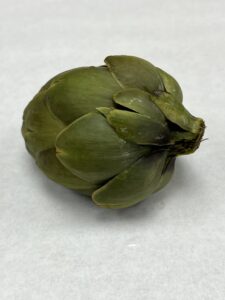


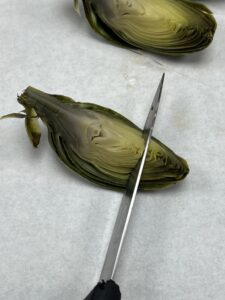
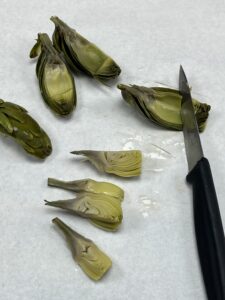
**TRY YOUR TECHNIQUE:**
Try Spring Lamb Loin Chops with Ragout of Baby Artichokes for the rich taste of the season.
SPRING LAMB LOIN CHOPS WITH RAGOUT OF BABY ARTICHOKES
Makes 4 servings of about 10 grams carbohydrates
and 30 grams of protein each
Prep time 30 minutes – Cook time about 15 minutes
24.baby or small artichoke hearts (C=24g)(P=8g)(F=12g)
2. tablespoons Extra VirginOlive oil (C=0g)
4. cloves of fresh garlic, sliced paper thin (C=4g)
1 cup miniature red, yellow and orange sweet peppers, cut into full circles (C=8g)
Sea salt (C=0g)
freshly ground black pepper (C=1g)
2. tablespoons chopped fresh rosemary (C=.4g)
1. lemon, juiced (C=3.6g)
8. baby lamb loin chops, thick cut about 3 ounces each trimmed (C=0g)(P=112g)
4. sprigs of rosemary for garnish (C=0g)
Preheat the grill.
In a large pot of boiling salted water, cook the artichokes until tender as tested by inserting a skewer without resistance into the heart through the base of the stem, about 15 minutes. Drain in a colander and allow to cool enough to handle the trimming. Quarter the artichokes then trim of the coarse outer leaves and fibrous stems. Reserve.
Meanwhile, heat the garlic slivers and olive oil over low to medium heat. Gently cook until the garlic is translucent and tender without browning, about 10 minutes. Turn the heat up to medium-high, add the peppers cooking until tender and sweet, about 8 minutes. Add the artichokes and rosemary cooking until heated through, about 3 minutes. Add the lemon juice and rind, cooking to reduced to coat. Remove from the heat and keep warm.
Sprinkle the lamb chops generously with the salt, pepper, the remaining rosemary and a drizzle of oil. Place on the grill cooking until well seared, about 5 minutes. Turn over cooking to your desired temperature, about 4 minutes for medium rare for thicker chops depending on thickness and grill temperature. Transfer to a clean plate and keep warm.
Mound the artichoke and pepper ragout in the center of warm serving plates. Position two lamb chops atop the artichokes. Drizzle the lamb with the remaining ragout juices. Sprinkle with a little fresh ground pepper. Garnish with the sprigs of rosemary. Serve immediately.
COOKING NOTE I: (C=0g)(P=0g)(F=0g)indicates the total carbohydrates, total protein & total fiber in grams for the ingredient listed.
© Jimmy Schmidt https://maisonchefgp.com/

